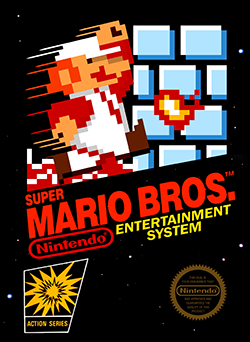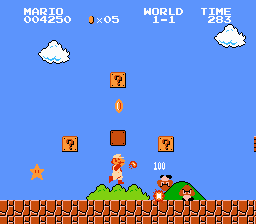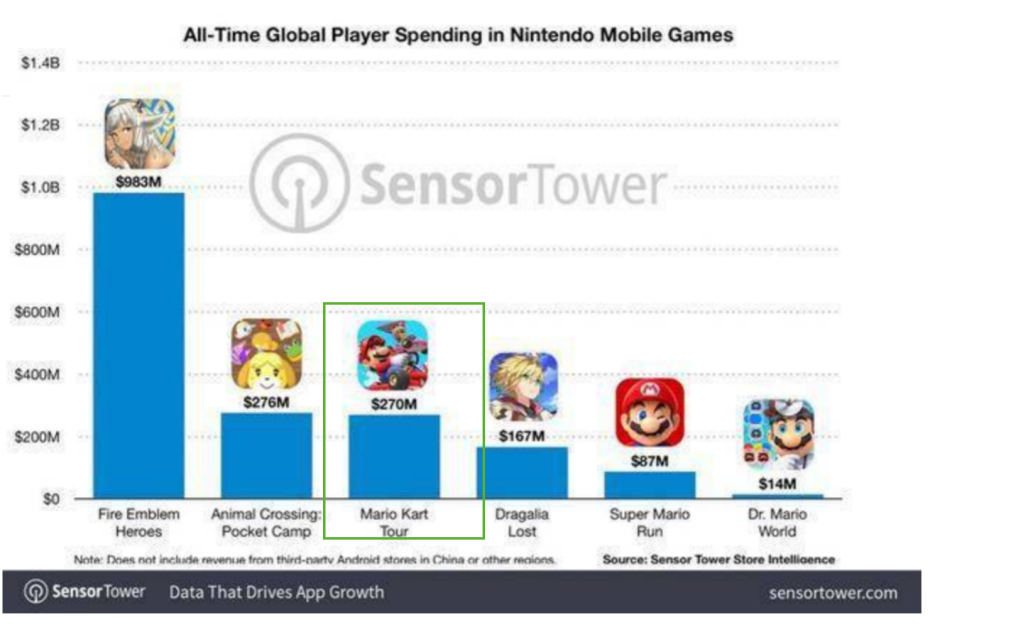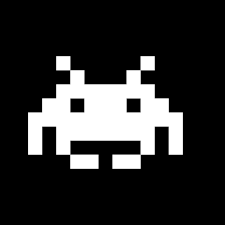About: Super Mario
Release Date: September 13, 1985
Publisher(s): Nintendo
Director(s) : Shigeru Miyamoto
Producer(s): Shigeru Miyamoto
Designer(s): Shigeru Miyamoto, Takashi Tezuka
Programmer(s): Toshihiko Nakago, Kazuaki Morita
Artist(s): Shigeru Miyamoto, Takashi Tezuka
Composer(s): Koji Kondo
Platform(s): Nintendo Entertainment System, arcade
Genre: Adventure games
Mode: Single-player, multi-player

Game Play
Super Mario is a 2D platform game released on the Nintendo Entertainment System in 1985. Super Mario extended many “Mario elements” such as Goombas, Koopa Troopas, Bowser, and Peach, as well as its three power-ups: Super Mushroom (increases the size of the character and provides additional hit points), Sparkle (allows the character to throw fireballs as weapons), and Super Star (grants temporary invincibility). Mario must rescue Princess Peach from King Bowser in the Mushroom Kingdom. The game is consisting of 8 different worlds and in total of 32 levels. The last level of each different world is fighting against Bowser. On the original NES game, using A on NES to jump, B on NES to run , the direction pad to move, holding B on NES whilst moving to dash. Also, the only way to defeat the enemies is jumping on them. Sometimes, before jumping, the players should run up to the object with B or Y. Super Mario have loads of blocks, the players could acquire useful props by hitting them. At the same time, it is more convenient to enter a underground pipe for the shortcut. At last but not the least, players should run whenever possible because of the time limiting.

Super Mario Bros.1 has always been regarded as one of the most greatest video games. It is one of the best-selling games of all time, with more than 58 million copies sold worldwide. When it was released in Japan, it sold 1.2 million copies in September 1985. Within four months, about 3 million copies were sold in Japan, almost equivalent to $72 million at the time. In the United States, more than 1 million copies of the NES version were sold in 1986, more than 4 million by 1988. Also, many people learned about the game through the arcade version, which sold 20,000 copies within a few months in early 1986, making it the best-selling version for the Nintendo VS system. Super Mario Bros.1 is considered as the key factor of reviving the video game industry after the 1983 crash that I will make a detailed description in social contexts.

Social context
Super Mario Bros.1 has always been regarded as one of the most greatest video games. The main factor is that the Super Mario “saved” the video game situation at that time.
In 1982, Atari paid $21 million for the game adaptation of “ET”. With the help of the movie’s fame, Atari believed that the game would have a great sell. Atari also gave the game only 5 weeks of development time in time for the Christmas season, the result is that the game“ET” was strongly criticized by players and only sold 100 million copies in total. The failure of the “ET” caused a chain connection that people refused to buy all games. As a result, the selling of the video games began to fall sharply. The United States stores started to take down these “electronic junk” . Atari, which had revenues of $2 billion in 1982, declared bankruptcy in 1983. However, after the released of the Super Mario, the work was redefining the infinite possibilities of video games. Super Mario Bros broke the limiting of the screen for the first time by introducing the revolutionary “horizontal scrolling” technology, which the game space has been greatly expanded. Super Mario Bros. also established the rule that the characters should “walk from left to right”, and this became the golden models for other video games in next ten years. That’s exactly why the critical analysis of the game has been very positive. Video Games Monthly ranked it the No.1 on its list of the “200 Greatest Games of Our Time”. IGN included it in its list of the best 100 games in 2005 and 2007.
Culture context
The image of a middle-aged man wearing a red hat, backpack overalls, a big nose and beard, and a slightly obese figure is Nintendo’s most important IP asset. Mario’s image as a “global citizen” has not prevented him from becoming a national “group favorite” or a “national treasure” in Japan, but has also become one of the most important symbols of Japan’s national image by constantly breaking the next-generation barrier. It has become one of the important symbols of Japan’s national image by constantly breaking the next-generation barrier.
In 2016, in the “Eight Minutes in Tokyo”, the most eye-catching part of the closing ceremony of the Rio Olympics, the Prime Minister of Japan disguised as Super Mario, wearing the iconic red hat. Rising from the “green pipe” set up in the center of the Maracana Stadium, the whole stadium roared with cheers and applause.

In this sense, Super Mario has been transformed from a game IP into an iconic symbol, incorporated into the national ceremonial occasion, and gained global dissemination and recognition, which is the best case of national image construction in the game field.
One of the important reasons why “Super Mario” became popular is that it is not called “Super Tanaka”, “Super Yamamoto” and “Super Nakamura”. The image of Super Mario is not a Japanese figure, but an American plumber with a Mexican beard and an Italian accent, designed by a Japanese person, which has become a common cultural symbol worldwide.
Like many Japanese product brands designed for the international market since the 1980s, Mario has perfectly leveraged the power of cultural communication through its hybrid identity.
